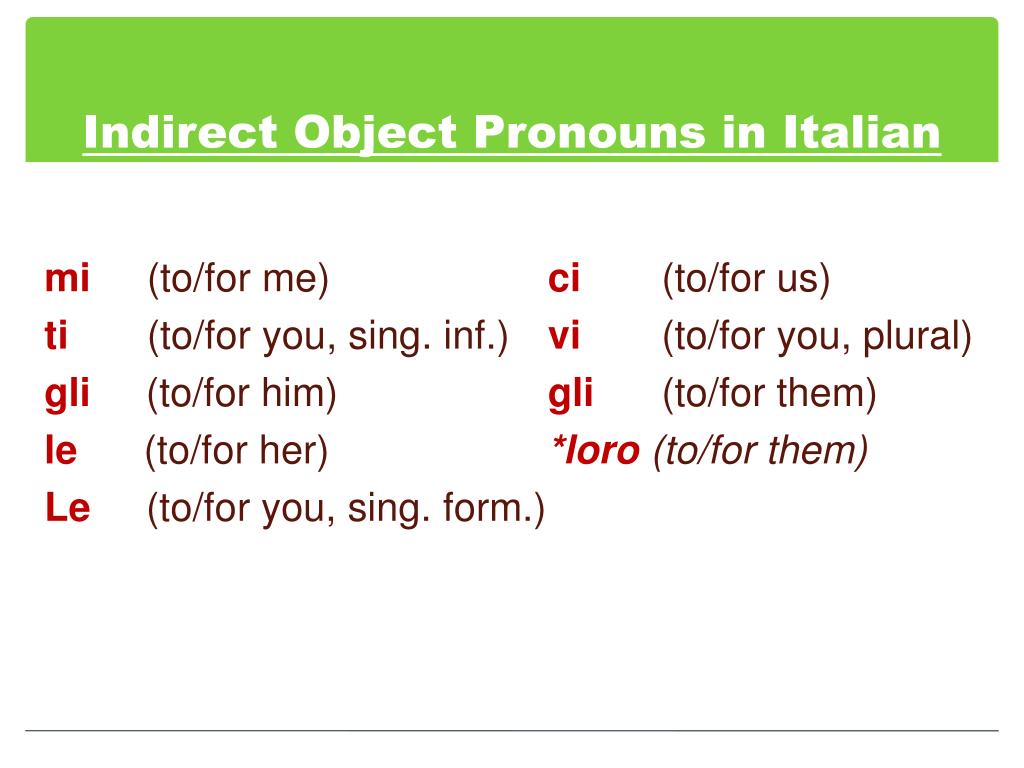
Direct Object Pronouns in Italian YouTube
mi, ti, gli, le, ci, vi, gli Here is a small list of common verbs with indirect pronouns: Watch out, don't think too much in your own language. Some verbs work differently in Italian than in other languages and may use different kind of pronouns. Verbs with direct pronouns

Direct and Indirect Pronouns in Italian Commonly Used Words
Pronomi indiretti MI or A ME? In normal sentences, the pronouns mi, ti, gli, etc. are always used (they are called unstressed pronouns, in Italian pronomi atoni ). The pronouns a me, a te, a lui, etc. (which are stressed pronouns, called pronomi tonici in Italian) are used in the following cases:

How to use Italian Direct and Indirect Object Pronouns in Context (sub
04/08/2023 While direct object pronouns answer the question "what?" or "whom?" Indirect object pronouns answer the question "to whom"? or "for whom"? Using indirect object pronouns in place of the noun can help spoken and written language flow more naturally.

What are Direct and Indirect Pronouns Pronouns
In Italian there are two forms of indirect pronouns (pronomi indiretti). Unaccented (deboli/atoni: mi, ti, gli, le, ci, vi, gli) when the accent falls on the verb, and accented (forti/tonici: a me, a te, a lui, a lei, a noi, a voi, a loro) when the accent falls on the pronoun. Do la chiave a lui = a lui is accented, the whole sentence and the.

Italian Verbs With Direct or Indirect Object Instantly Italy
Indirect Object Pronouns in Italian: Vocabulary Mi = to me/for me Ti = to you/for you Gli = to him/for him Le = to her/for her Ci = to us/for us Vi = to you/for you (plural "you", when speaking to two or more people) Gli = to them/for them Do = I give Questo = this Ti = to you/for you Ti do questo = I give this to you Compro questo = I buy this

Italian Indirect Object Pronouns YouTube
Indirect object pronouns ( pronomi complemento indiretto) are pronouns that substitute for nouns that serve as the indirect object of the sentence verb, indicating to whom or to what (or for whom or for what, with whom or with what, etc.) an action was done.

Pin on Italian
Reported speech: indirect speech - English Grammar Today - a reference to written and spoken English grammar and usage - Cambridge Dictionary

Direct Object Pronouns I Pronomi Italian language learning
Here is a list with all the Italian indirect pronouns! 1a personal singolare mi (a me) - plurale ci (a noi) 2a persona singolare ti (a te) - plurale vi (a voi) 3a persona (maschile) singolare - gli (a lui) - gli / loro (a loro) 3a persona (femminile) singolare - le (a lei) - gli / loro (a loro) 3a persona (forma di cortesia sia femminile che.

Direct and Indirect Object Pronouns Italian Exercises
Practice the Italian indirect object pronouns with our online interactive exercises - for beginners, advanced learners and experts! The system gives you full control of the level of difficulty and you can progress as you please and at your own pace. All execises come with a translation of the vocabulary allowing you to practice freely without.
/GettyImages-645446997-576f2ff65f9b585875db6b82.jpg)
Indirect Object Pronouns in Italian
DIRECT and INDIRECT Pronouns in Italian: how to use them! Ok… In this lesson we decided to explain (and make you understand) what direct and indirect pronouns in Italian are and how they are used! Let's start! Pronomi DIRETTI e INDIRETTI in italiano: la Spiegazione Completa in MENO di 10 MINUTI! Watch on DIRECT and INDIRECT Pronouns in Italian

Italian Indirect Object Pronouns A Simple Guide Learn Italian Go
WHAT IS AN INDIRECT PRONOUN Indirect objects are nouns or noun substitutes that typically need a preposition to make the phrase meaningful. For example: " I speak to Laura " becomes meaningless if we say " I speak Laura ." Pronouns that stand for or replace an indirect object are called indirect object pronouns

PPT Indirect Object Pronouns PowerPoint Presentation, free download
Italian indirect object pronouns Per esempio… Notes The first and second person indirect object pronouns are identical to the first and second person direct object pronouns. Capitalized Le is the formal indirect object pronoun to be used with people you address as Lei. Word order

Your Italian Tutor Italian indirect object pronouns
In the last one, the indirect pronoun le stands for "to her" and it's replacing "a Chiara". Direct pronouns and indirect pronouns: what's the difference? There are two types of pronouns in Italian: direct object pronouns and indirect object pronouns. What makes indirect pronouns different from direct pronouns?

Italian Direct, Indirect & Double Object Pronoun Review YouTube
These are used with verbs that do not take the preposition 'a' in Italian. Some verbs that take direct object pronouns In Italian, that are actually indirect in English: Ascoltare - to listen to. Aspettare - to wait for. Cercare - to search for. Guardare - to look at. Notice there is no need for the preposition in Italian!

Indirect Object Pronouns in Italian YouTube
Let's test your knowledge of Italian indirect object pronouns. Fill in the blanks in these sentences using the correct indirect object pronoun. If you found this lesson powerful, then you'll love Intrepid Italian, my series of online self-paced video courses that break down everything you need to know about Italian using my 80/20 method.

Italian Indirect Object Pronouns A Simple Guide Learn Italian Go
What are the Italian indirect object pronouns, and how do they work? A pronoun is a part of speech that replaces a name or a person to avoid repeating them directly in a sentence. This is why they are called pronomi in Italian, from the Latin pro, "in place of", and nomen, "name". Ho regalato a mamma una matita. Le ho regalato una matita.